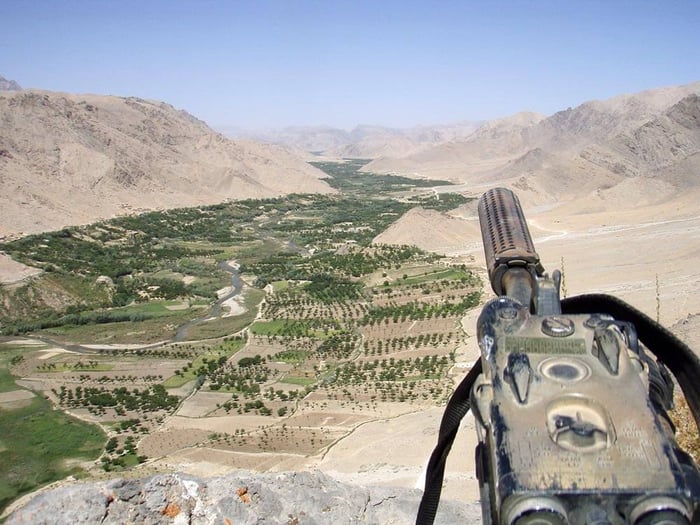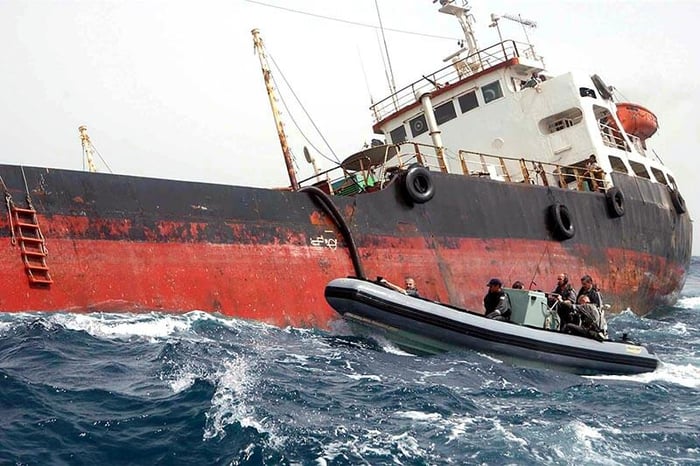
Climb Aboard
In January 2004 when the first member of an Australian Navy boarding party, attempting to fast-rope onto the illegal fishing vessel Maya V fell overboard, he succeeded in proving one obvious fact - naval boarding operations can be extremely dangerous.
Were it not for the real danger our sailors face on the high seas, what happened next could read like a comedy of errors.
But first - a little background.
The Australian Navy, like most navies around the world, hones and practices the capability to board ships on the open ocean, as a basic tool of trade.
Although it may sound simple, to leave the safety of one's own ship and climb aboard another in open water poses myriad problems and dangers.
Falling is perhaps the most obvious and potentially the most dangerous of all the hazards - yet it is, not surprisingly, easily done. Consider the forces of nature operating against our sailors as they try to scale the sheer, cliff-like side of a target ship - high winds, rough seas, ice, spray and so on. Not to mention the fact that this sheer steel cliff is rocking and rolling and bobbing on a turbulent sea.
But don't think for a minute that to fall is simply a matter of getting wet. Sea temperatures in the Great Southern Ocean can freeze a man to death in a few minutes if rescue is not quickly at hand. Then there's the real risk that a fall could be broken by something much more solid than water before the big splash, rendering a hapless sailor unconscious and in real risk of drowning.
Obviously, strict safety precautions, careful planning and hours of training can help mitigate the danger - but you simply can't prevent every slip, trip or tumble.
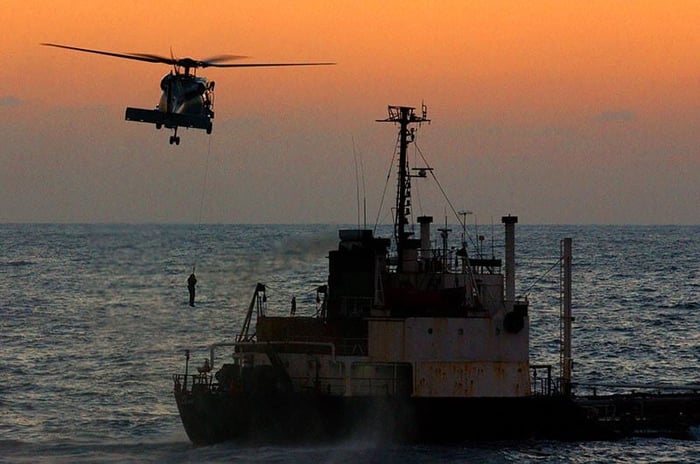 Helicopter boarding
Helicopter boarding
There are various methods of boarding a ship at sea. Two basic approaches can be made - from the water or from the air.
Approaching a ship from the water is done by RHIB (rigid-hulled inflatable boat).
If the crew is complying with instructions, the target ship continues running with the weather - surfing the waves to minimise turbulence - while the boarding team approaches from the rear quarter that offers the best shelter.
When the RHIB pulls along side, ropes or ladders are either thrown down by a compliant crew or, if the crew is not cooperating for whatever reason, the boarding party cast ???grappling hooks??? over the rails to get the first man on board.
After shimmying up a rope ladder - developed in Australia in response to our sailors' design demands based on their experiences in The Persian Gulf - the first man on deck secures further ropes and ladders to facilitate easier boarding by his teammates.
Getting all his team on board as quickly as possible - without falling - is a priority for the team leader, still in the RHIB. A split team makes for poor command and control.
If one member does fall, however, the team leader has a snap decision to make - to rescue a man overboard (who may have been rendered unconscious by the fall) or first getting the lone climber off the target ship, thus keeping his team together.
If, however, the first member aboard the target ship had already been joined by a colleague to watch his back, then the man in the water becomes priority one, without question.
At this point, while the team is split and individuals are concentrating on the physically demanding task of hauling themselves and their equipment up a rope ladder - while being jostled, bumped and otherwise assaulted by Mother Nature - the team is probably at its most vulnerable from its other main danger - a hostile crew.
 Boarding party shotgun
Boarding party shotgun
Boarding teams are trained in self-defence techniques as well as a range of small arms including 9mm pistol and 12-gauge shotgun.
However, non-compliant crews on the usually civilian or merchant target vessels are much more likely to employ passive defences than openly hostile action. For example, ships' crews in The Persian Gulf sometimes smeared railings and ladders with grease, flooded decks with crude oil, welded doors and hatches shut, or even welded spikes to the side of their ship, in deliberate attempts to thwart boarding parties.
The other main method of boarding a target ship is by fast-roping from a Seahawk helicopter. While a RHIB approach is usually the favoured platform for boarding, an aerial approach might be quicker.
But while fast-roping from a hovering helicopter may seem like an ideal method of boarding, the dangers are high.
Fast-roping is a method of descent whereby, unlike abseiling, the descending sailor is not fastened to the rope by carabiner or other mechanical safety harness. The sailor slides down the thick rope, fireman's-pole fashion, using his feet for friction and holding the rope close to his chest for stability.
While this is obviously a very quick method of descent - hopefully not too quick - the inherent danger of descending, say 10 meters on a fast rope are complicated when the deck on which the sailor intends to land is suddenly just 5 meters below him and then, just as suddenly, 25 meters below.
Such movement could also cause the pilot more than just a little anxiety, especially in close proximity to masts, antennae, cranes or other obstacles potentially lethal to his aircraft.
Leut Paul Welch, a boarding party team leader aboard HMAS Anzac, says the teams on his ship maintained an immediate-notice-to-board watch and that the RHIBs were far better suited to this tempo.
"Helicopters require a lot of forethought and a lot of logistics, but you can put the boats in the water very quickly and get on with the boarding," he says.
"When everything is spontaneous, like boardings non-compliant vessels trying to make a run, the boats were a lot easier and a lot more effective."
Crews on the 7.2 meter RHIBs were usually dedicated to the task and became very proficient. It was a tried and trusted method and proved very safe.
Leut Welch says boarding operations, while inherently dangerous, are basically exciting, exhilarating activities.
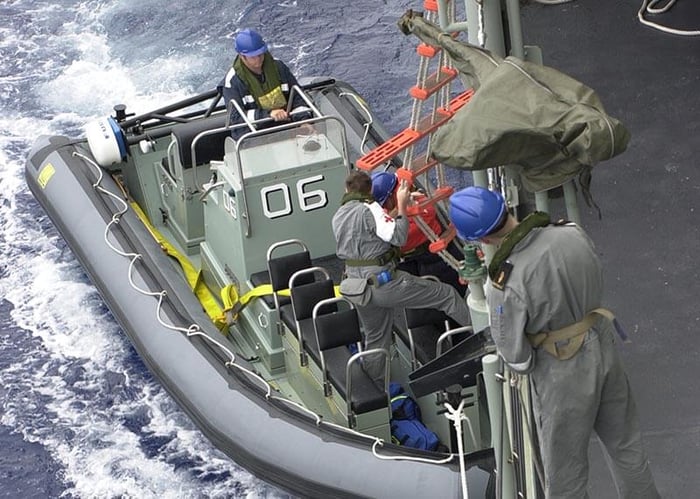 Boarding party
Boarding party
"Given that there's so much adrenaline flowing at that stage, you are, I guess, super aware and anxious more than scared.
"But we trained over and over and we did so many boardings all the time that you kick into a routine."
The first tasks for the boarding party, once all the team are safely aboard, is to secure the bridge and engine spaces and muster the ship's crew. Once this happens, the threat is considered much lower and the next phase - the investigative phase - of the boarding can commence.
While the ship's captain is questioned about his intentions and his cargo, he almost always remains in command of his ship and is fully responsible for all aspects of its safe running. If the boarding party are in a position to help with first aid or any other issue that needs attention they will help out, but very rarely take control of the ship's operation.
Assuming full control of the ship is done only in exceptional circumstances and is a decision not normally taken at the team-leader level. The boarding-party team leader consults with the ???war room??? on board the parent ship via HF radio, outlining his circumstances, before a decision is made at higher levels.
Splitting up, but always working in at least pairs for safety, the boarding party next commence what is, more often than not, the hot, dirty, claustrophobic task of searching every compartment of the ship.
In the case of a small illegal fishing boat off Ashmore Reef, such searches can be conducted quickly and relatively easily, by three or four sailors. But, in the case of a large container ship suspected of trying to run contraband oil, dates, weapons or uranium past the UN blockade on Iraq, well...
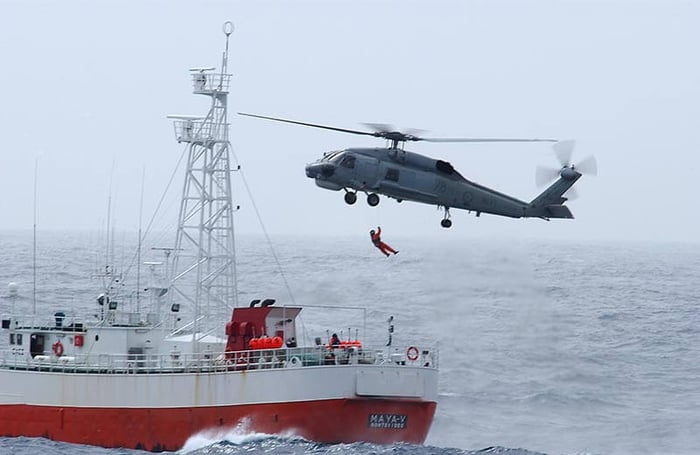 Helicopter boarding
Helicopter boarding
Two full teams of 12 could spend an entire day abseiling down the faces of shipping containers stacked several rows high, searching each one and reconciling their contents against the ship's manifest. And after that, there are acres of dark, dank compartments below decks.
Boarding party duty is not a specialist trade. Party members are selected from almost any part of the ship's crew, although weapons' user and engineering categories are generally favoured.
There are only so many people on a ship - about 180 - to choose from for boarding duties and some sailors are automatically ruled out because they are required to maintain normal operations on their own ship.
Those who are selected must, in the first instance, be willing to participate, given that they are often required to fulfil their normal duties on top of the boarding-party workload.
Leut Welch says gender is not a barrier to selection, but physical fitness is obviously a major factor.
"It's a very physically demanding job because you are frequently hauling yourself and your equipment up vertical ladders - while battling the elements as well.
"Plus, teams can work very long hours with little sleep.
"It's certainly not an easy job, or comfortable, but it is very rewarding. I'd encourage anyone to give it a go."
Getting back to that not-so-funny comedy of errors reference... when a RHIB was despatched to rescue the hapless sailor who fell in the water - uninjured - while trying to fast-rope onto the illegal fishing vessel Maya V, the RHIB flipped in the rough seas tossing its crew of three into the water as well.
Suddenly, what was a tricky boarding attempt in poor weather suddenly turned into a full-scale rescue emergency for the ship's company aboard HMAS Warramunga.
While all crew members were rescued uninjured, the incident did three things; highlighted the dangers faced by our sailors operating on the high seas thousands of miles from home; highlighted the high levels of training and professionalism extant in our Navy crews; and, gave boarding parties on sister ships throughout the Navy a real good excuse to rib their mates on Warramunga, the next time a beer is shared.
Created by our friends at: Contact Magazine
Images: ADF






